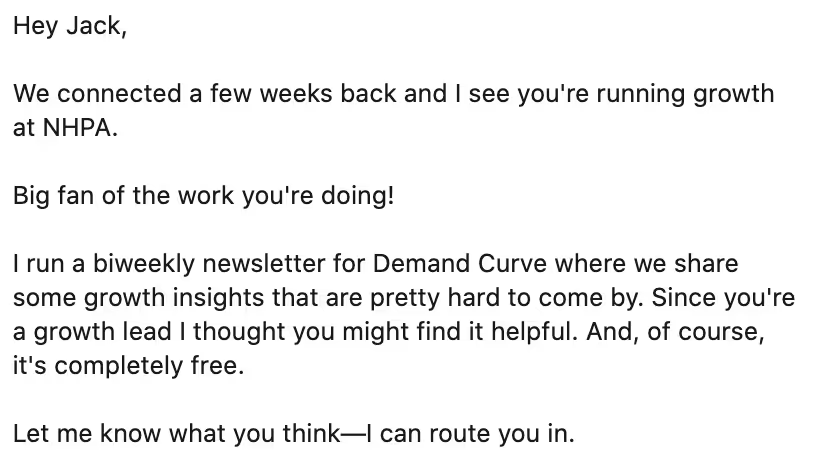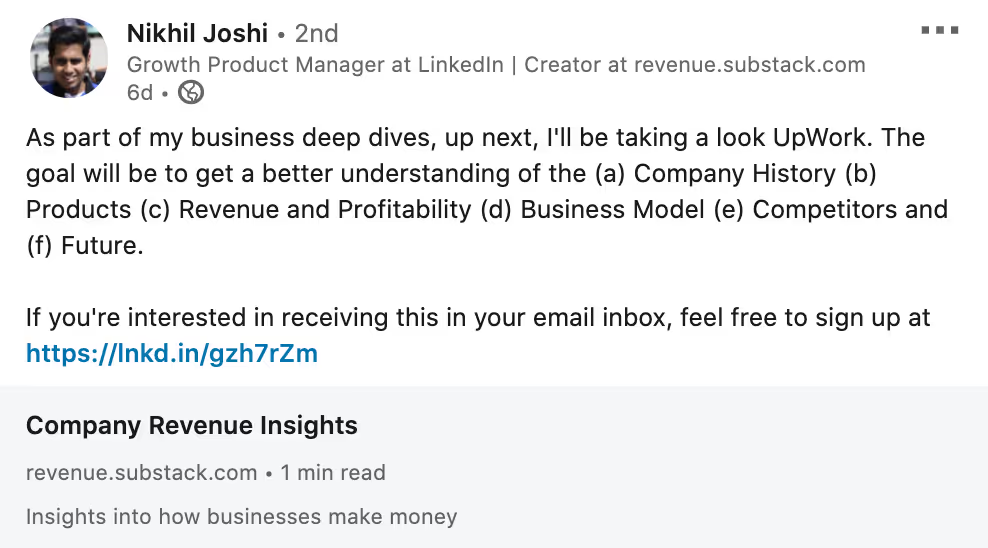
Conversation

🥳 Feedback Received!
Thanks for taking a moment to share your thoughts — it genuinely helps us make each chapter sharper.
What happens next:
- Your feedback goes straight to our product team.
- We’ll use it to refine lessons, clarify examples, and make the program even more useful.
Appreciate you helping make this program better for everyone.
Ready for your next challenge? 👇
Getting Email Addresses
Ok, let's take a step back.
So far, we've covered:
- Connecting with sub-audiences
- Posting content to get engagement and new followers
Our goal on LinkedIn is getting a soft conversion—typically an email address. We add that email address to a drip campaign to eventually generate revenue.
But it's not easy to take people off LinkedIn. This is where most LinkedIn funnels break.
And that's by design—LinkedIn wants people to stay on-platform.
When we spoke to LinkedIn audience builders, one shared that only 5% of his 100k+ followers are signed up for his newsletter.
Methods of collecting emails
We've identified two ways to capture emails from your LinkedIn audience.
- Send direct messages (DMs) to your audience members with a valuable free resource that requires their email address to see it.
- Build a system around capturing email addresses through your content.
- Gate your best insights so that readers need to provide an email address to see them.
- Occasionally link to landing pages to capture emails in exchange for resources like newsletters or one-pagers.
1. DM strategy
If you already have valuable, free resources to entice connections with, sending direct messages offering that resource is an effective strategy. Require them to provide their email address in order to get the resource.
They'll trust you if you've been posting insightful and human posts for a while. That's how this LinkedIn strategy ties together.
In fact, the best way to get DM responses is to have first commented on your recipients' posts. This surfaces you on their radar and builds the expectation of reciprocity.
Here are some examples of valuable free products to offer:
- Truly useful email newsletters—insightful, actionable newsletters that get people excited.
- Databases such as lists of recruiters, VC funds, and job opportunities.
- In-depth guides—long form educational content.
If you don’t have an existing asset such as these, head to the "Capturing emails through your content" section.
How to DM your connections
The DM conversation isn't where the end conversion happens. Users don't trust you enough to make a purchase just yet.
So instead of following the scripted sales approach, provide genuine value.
The goal is twofold:
- Get email addresses you can send drip emails to.
- Get them to trust your brand by seeing how valuable your resources are.

Two examples of DM templates you can use:
- “Btw I put together a spreadsheet of the best VCs with their contact information. Since we went through YC we thought this would be helpful to founders looking for funding. We keep it gated and only share it with top founders. If you want to take a look just shoot me your work email and I'll get it to you."
- "Heads up that my team and I wrote a thorough playbook on landing page optimization. Happy to share with you if you think it'd be helpful. We keep it gated and only share it with top founders and marketers. If you want to take a look just shoot me your work email and I'll get it to you."
Connections that receive this message get a relevant free resource and there are no strings attached. Why wouldn't they join?
And just like that, we've got an email address.
Is this a lot of work? Yes. But, on LinkedIn, you know you’re targeting all the firmographically-appropriate leads. You’re not spraying and praying. Everyone is worth something to you.
Insight: Don't DM right away
Try waiting at least a month after connecting with folks so your audience has had time to digest your insightful posts before you reach out.
2. Capturing emails within LinkedIn content
Here's the best approach we've identified for capturing emails directly from your posts:
- Regularly post insightful content without asking for anything—including emails.
- One out of every 5 posts, provide half of your content then require that they click a link and enter their email to get the other half.
In other words, first build trust that your content is good. Then tease them with something that requires a small transaction.
Build up from there.


LinkedIn also offers onsite newsletters where you can embed CTAs to capture emails:

Getting the purchase
Now that you have a steady flow of new leads’ email addresses, we’re officially moving beyond LinkedIn—the platform has done its job.
This is the start of the final stage of your funnel—purchase conversion—where you’ll leverage email drips to sell to your leads.
Drip campaigns are important enough to cover in an entire playbook, but here’s how we view final conversion in the context of your LinkedIn funnel:
Since you’ve done the hard work of building affinity through your LinkedIn content, your leads should be excited to consume everything you create. A portion of your leads will be willing to pay for your products or services now that they know who you are, trust you, and view you as a thought leader.
Well-done drip campaigns get those leads across the finish line.


